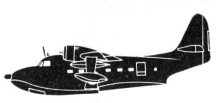
ASN Wikibase Occurrence # 323886
| Date: | Saturday 26 September 1998 |
| Time: | 09:45 |
| Type: |  Grumman HU-16C Albatross |
| Owner/operator: | private |
| Registration: | N7025J |
| MSN: | G-293 |
| Year of manufacture: | 1953 |
| Total airframe hrs: | 4119 hours |
| Engine model: | Curtis Wright R-1820-76 |
| Fatalities: | Fatalities: 0 / Occupants: 6 |
| Aircraft damage: | Substantial, repaired |
| Category: | Accident |
| Location: | Sedona Airport, AZ (SDX) -
 United States of America United States of America
|
| Phase: | Landing |
| Nature: | Private |
| Departure airport: | Flagstaff-Pulliam Field, AZ (FLG/KFLG) |
| Sedona Airport, AZ (SDX/KSEZ) | |
| Investigating agency: | NTSB |
| Confidence Rating: |
A Grumman HU-16C, N7025J, veered off runway 3 on the landing rollout at the Sedona, Arizona, airport. The airplane sustained substantial damage. The private pilot/owner, two flight crewmembers, and three passengers were not injured.
The aircraft owner held a private pilot certificate with a type rating in the Grumman HU-16C, and was in the right seat. The second pilot, who was in the left seat and manipulating the flight controls, held airline transport pilot and flight instructor certificates, but was not type rated in the aircraft. The second pilot had a total of 1.9 hours in the aircraft.
The owner stated that as they approached Sedona, reported winds were from 180 degrees at 10 to 15 knots; however, other airplanes were reporting using runway 3 for landings. He stated that they entered downwind midfield for runway 3. There were no discrepancies noted with the approach or touchdown, and the initial rollout was "normal." The owner reported that when the second pilot selected propeller reverse power, the left engine came in before the right engine and caused a slight deviation to the left. He stated that braking was used to correct the heading. After the initial correction the right brake locked. The owner stated that the propellers were brought out of reverse and the aircraft continued to exit the left side of the runway. He noted that the right tire failed "sometime" during the rollout.
The manager for Red Rock Aviation, a Fixed Based Operator (FBO) at the airport, reported that UNICOM was advising runway 21 as the active runway, and that the winds were from 180 degrees at 9 knots gusting to 14 knots.
PROBABLE CAUSE: "The pilot in command's selection of the wrong runway for the prevailing wind conditions, and the second pilot's inadequate compensation for the winds. Factors in the accident were the second pilot's lack of experience in the aircraft and the pilot-in-command's inadequate supervision of the flight. Additional factors were the variable and gusty, cross wind and tail wind conditions."
Accident investigation:
 |
|
Sources:
NTSB
Revision history:
| Date/time | Contributor | Updates |
|---|
The Aviation Safety Network is an exclusive service provided by:


 ©2024 Flight Safety Foundation
©2024 Flight Safety Foundation